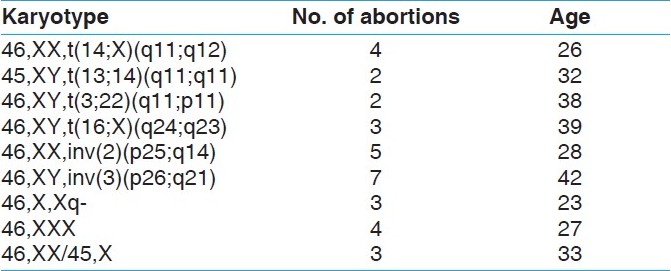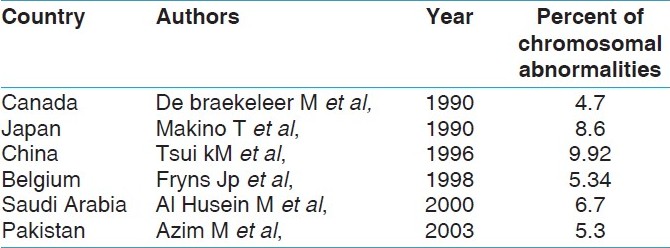|
 
 |
|
ORIGINAL ARTICLE |
|
|
|
| Year : 2011 | Volume
: 17
| Issue : 2 | Page : 82-84 |
| |
Chromosomal abnormalities as a cause of recurrent abortions in Egypt
Faeza Abdel Mogib El-Dahtory
Department of Genetics Unit of Children Hospital, Mansoura University, Mansoura, Egypt
| Date of Web Publication | 17-Oct-2011 |
Correspondence Address:
Faeza Abdel Mogib El-Dahtory
Genetic Unit of Children Hospital, Mansoura University, Mansoura
Egypt
 Source of Support: None, Conflict of Interest: None
DOI: 10.4103/0971-6866.86186

 Abstract Abstract | | |
Background: In 4%-8% of couples with recurrent abortion, at least one of the partners has chromosomal abnormality. Most spontaneous miscarriages which happen in the first and second trimesters are caused by chromosomal abnormalities. These chromosomal abnormalities may be either numerical or structural.
Material and Methods : Cytogenetic study was done for 73 Egyptian couples who presented with recurrent abortion at Genetic Unit of Children Hospital, Mansoura University.
Results : We found that the frequency of chromosomal abnormalities was not significantly different from that reported worldwide. Chromosomal abnormalities were detected in 9 (6.1%) of 73 couples. Seven of chromosomal abnormalities were structural and two of them were numerical.
Conclusion : Our results showed that 6.1% of the couples with recurrent abortion had chromosomal abnormalities, with no other abnormalities. We suggest that it is necessary to perform cytogenetic in vestigation for couples who have recurrent abortion.
Keywords: Chromosomal abnormalities, cytogenetics, recurrent abortions
How to cite this article:
Mogib El-Dahtory FA. Chromosomal abnormalities as a cause of recurrent abortions in Egypt. Indian J Hum Genet 2011;17:82-4 |
How to cite this URL:
Mogib El-Dahtory FA. Chromosomal abnormalities as a cause of recurrent abortions in Egypt. Indian J Hum Genet [serial online] 2011 [cited 2016 May 13];17:82-4. Available from: http://www.ijhg.com/text.asp?2011/17/2/82/86186 |
 Introduction Introduction | |  |
Approximately 15%-20% of clinically recognizable pregnancies end in spontaneous abortion. [1] In 4%-8% of couples with recurrent pregnancy loss, at least one of the partners has chromosomal abnormality that probably contains balance chromosomal abnormalities. [2] These chromosomal abnormalities may be either numerical or structural. [3] This result from the production of gametes and embryos with unbalanced chromosome sets. [4],[5] The clinical consequences of such abnormal gametes include sterility, repeated abortions, and giving birth to malformed children. [6],[7] The majority of chromosome rearrangements are balanced reciprocal and Robertsonian translocations. It is known that such abnormalities cause no phenotypic effect on the carrier but lead to increased risk to produce unbalanced gametes. Therefore, they have not only high risk to give abnormal offspring with unbalanced karyotypes, but also have increased prevalence of miscarriages. [8],[9]
The aim of this study was to determine the chromosomal abnormalities in Egyptian couples with recurrent abortion refer to Cytogenetic Unit of Children Hospital, Mansoura University.
 Materials and Methods Materials and Methods | |  |
After exclude immunologic effects, uterine malformations and other causes of recurrent abortion, 73 couples with at least two pregnancy losses were referred to Cytogenetic Unit of Mansoura University Children Hospital. The mean age of the females was 27 years, while it was 31 years for the males. Chromosomes were obtained from peripheral blood cultures according to Rooney and Czepulkowski. [10] Three to five milliliter of sodium-heparinized whole blood was collected from each patient and control individual. An amount of 0.5 cc of each patient and control individual's blood sample was added to 5 cc of a complete media containing RPMI 1640, fetal calf serum (10%), PHA (10 μg/ml), L-glutamate (2 mM), Penicillin (200 unit/ml), and Gentamycin (50 μg/ml). After 70 hours of incubation in 37°C, colcemide was added (0.2 μg/ml). After 90 min, the cells were harvested by centrifugation (150 ΄ g for 10 min). Then, 5 ml of 0.075 M KCl solution was added and mixed and incubated at 37°C for 15 min. After centrifugation (150 ΄ g for 10 min), hypotonic supernatant was removed. Then, 5cc cold, fresh fixative solution (3:1 methanol-acetic acid) was added drop-wise to the cell pellet. Centrifugation was done afterwards and the supernatant removed. These two latter steps were repeated until a clear pellet was obtained. Finally, cells obtained were dropped on distinct slides. Staining with Giemsa was performed for some of the slides prepared from each patient and analyzed by cytovision system.
[TAG:2]Results[/TAG:2]
A total of 73 Egyptian couples with history of recurrent abortion were examined. Their ages ranged from 20 to 46 years, with a mean of 29 years. The number of recurrent abortion varied from 2 to 10 abortions/couple, Chromosome abnormalities were found in (2/27)=7.4% of the couples with a history of two abortions, in (3/23)=13% with three abortions, and in (4/23)=17.39% with four or more abortions. Among these 73 couples, 9 (6.1%) were found to be carriers of different chromosomal abnormalities, five females (3.42%) and four males (2.74%). Seven of chromosomal abnormalities were structural and two of them were numerical. These abnormalities included three balanced reciprocal translocations, one Robertsonian translocation, two inversions, one case of mosaic X-chromosome monosomy, one trisomy X-chromosome and one deletion of short arm of chromosome X [Table 1]. | Table 1: Cytogenetic fi ndings, number of abortions and age in cases with abnormal karyotype
Click here to view |
 Discussion Discussion | |  |
Several studies have been carried out to determine the prevalence of chromosomal aberrations among couples with recurrent abortion. This was found to be 4.7%, 8.6%, 9.92%, 5.34%, 6.7%, and 5.3% in six of the largest reviews that were reported by De braekeleer et al., [11] Makino et al., [12] Tsui k et al., [13] Fryns et al., [14] Al Husein et al. [15] and Azim et al., [16] respectively [Table 2]. In our study, we found that the incidence of chromosomal abnormalities among couples with recurrent abortions was 6.1%, which is not significantly different from this global incidence. | Table 2: Global studies of chromosomal abnormalities found in couple with recurrent abortion
Click here to view |
Kiss et al. found that, Chromosome abnormalities were found in 5% of the couples with a history of two abortions, in 10.3% with three abortions, and in 14.3% with four or more abortions, [17] as a similar to this, in our study we found that (2/27) = 7.4% of the couples with a history of two abortions, in (3/23) = 13% with three abortions and in (4/23) = 17.39% with four or more abortions.
The structural chromosomal abnormalities that we encountered were divided into balanced reciprocal chromosomal translocations (3/9), Robertsonian translocation (1/9), inversions (2/9) and deletion (1/9). The distribution of structural chromosomal rearrangements in our study is similar to that reported worldwide by. [18],[19],[20]
Autosomal reciprocal translocations have been proposed as the most common chromosomal changes in couples who have recurrent abortion. [21],[22],[23] In the same way, reciprocal translocations were the most common abnormalities (2.05%) in our studies as reported in literature.
Numerical chromosomal aberrations are less frequently encountered among couples with repeated abortions. Those aberrations are usually in the form of sex chromosomal aneuploidy, and they occur in a low frequency (<0.15% of cases). [24] We encountered one case with X-chromosome mosaicism and one case with trisomy X.
In conclusion, our results showed that, 6.1% of the couples with recurrent abortion had chromosomal abnormalities, with no other abnormalities. We suggest that it is necessary to perform cytogenetic in vestigation for couples who have recurrent abortion.
 References References | |  |
| 1. | Dejmek J, Vojtassak J, Malova J. Cytogenetic analysis of 1508 spontaneous abortions originating from South Slovakia. Eur J Obstet Gynecol Reprod Biol 1992;46:129-36 
|
| 2. | Kavalier F. Investigation of recurrent miscarriages. BMJ 2005; 331:121-2 
|
| 3. | Sierra S, Stephenson M. Genetics of recurrent pregnacy loss. Semin Reprod Med 2006;24:17-24. 
[PUBMED] [FULLTEXT] |
| 4. | Lindenbaum RH, Bobrow M. Reciprocal translocations in man: 3:1 meiotic disjunction resulting in 47-45 chromosome offspring. J Med Genet 1975;12:29-43. 
[PUBMED] [FULLTEXT] |
| 5. | Stene J, Stengel-Rutkowski S. Genetic risks for familial eciprocal translocations with special emphasis on those leading to 9p, 10p, 12p, trisomies. Ann Hum Genet 1982;46:41-74. 
[PUBMED] |
| 6. | Chandley AC, Edmond P, Christie S, Gowans L, Fletcher J, Frackievicz A, et al. Cytogenetics and infertility in man. I: Karyotype and seminal analysis: Results of a five-year survey of men attending a subfertility clinic. Ann Hum Genet 1975;39:231-54. 
|
| 7. | Neri G, Serra A, Campana M, Tedeschi B. Reproductive risks for translocations: Cytogenetic study and analysis of pregnancy outcome in 58 families. Am J Med Genet 1983;16:535-61. 
[PUBMED] |
| 8. | Tharapel AT, Tharapel SA, Bannerman RM. Recurrent pregnancy losses and parental chromosome abnormalities: A review. Br J Obstet Gynaecol 1985;92:899-914. 
[PUBMED] |
| 9. | Sierra S, Stephenson M. Genetics of recurrent pregnacy loss. Semin Reprod Med 2006;24:17-24. 
[PUBMED] [FULLTEXT] |
| 10. | Rooney DE, Czepulkowski BH. Human Chromosome Preparation, Essential Techniques Series, D. Rickwood, Department of Biological and Chemical sciences, University of Essex, Wivenhoe Park, Colchester, UK: University Press; 1997. p. 37-8. 
|
| 11. | De Braekeleer M, Dao TN. Cytogenetic studies in couples experiencing repeated pregnancy losses. Hum Reprod 1990;5:519-28. 
[PUBMED] [FULLTEXT] |
| 12. | Makino T, Tabushi T, Nakada K, Iwasaki K, Tamura S, Iizuka R. Chromosomal analysis in Japanese couples with repeated spontaneous abortions. Int J Fertil 1990;35:266-70. 
|
| 13. | Tsui KM, Yu WL, Lo FM, Lam TS. A cytogenetic study of 514 Chinese couples with recurrent spontaneous abortion. Chin Med J (Engl) 1996;109:635-8. 
[PUBMED] |
| 14. | Fryns JP, van Buggenhout G. Structural chromosome rearran-gements in couples with recurrent fetal wastage. Eur J Obstet Gynecol Reprod Biol 1998;81:171-6. 
[PUBMED] [FULLTEXT] |
| 15. | Al Hussain M, Al-Nuaim L, Abu Talib Z, Zaki O. Cytogenetic study in cases with recurrent abortion in Saudi Arabia. Ann Saudi Med 2000;20:233-6. 
|
| 16. | Azim M, Khan AH, Khilji ZL, Pal JA, Khurshid M. Chromosomal abnormalities as a cause of recurrent abortions: A hospital experience. J Pak Med Assoc 2003;53:117-9. 
[PUBMED] |
| 17. | Kiss A, Rosa RF, Dibi RP, Zen PR, Pfeil JN, Graziadio C, Paskulin GA. Chromosomal abnormalities in couples with history of recurrent abortion. Rev Bras Ginecol Obstet 2009;31:68-74. 
[PUBMED] [FULLTEXT] |
| 18. | Boue A, Boue J. Chromosome structural rearrangements and reproductive failure. In: Bennett MD, Bobrow M, Mewitt CM, editors. Chromosomes today. Vol 7. London: Allen and Unwin, 1981. p. 282-90. 
|
| 19. | Butler MG, Hamill T. Blood specimens from patients referred for cytogenetic analysis: Vanderbilt University Experience from 1985 to 1992. South Med J 1995;88:309-14. 
[PUBMED] [FULLTEXT] |
| 20. | Chandley AC. Infertility and recurrent abortions. In: Emery A, Rimoin D, editors. Principles and practice of medical genetics. London: Churchill Livingstone; 1990. p. 313-9. 
|
| 21. | Fryns JP, Van Buggenhout G. Structural chromosome rearrangements in couples with recurrent fetal wastage. Eur J Obstet Gynecol Reprod Biol 1998;81:171-6. 
[PUBMED] [FULLTEXT] |
| 22. | Elghezal H, Hidar S, Mougou S, Khairi H, Saâd A. Prevalence of chromosomal abnormalities in couples with recurrent miscarriage. Fertil Steril 2007;88:721-3. 
|
| 23. | Goddijn M, Leschot NJ. Genetic aspects of miscarriage. Baillieres Best Pract Res Clin Obstet Gynaecol 2000;14:855-65. 
[PUBMED] |
| 24. | Campana M, Serra A, Neri G. Role of chromosome aberrations in recurrent abortion: A study of 269 balanced translocations. Am J Med Genet 1986;24:341-56. 
[PUBMED] |
[Table 1], [Table 2]
| This article has been cited by | | 1 |
A correlation analysis between the expression of pregnancy-associated plasma protein A in basal decidual cells and recurrent spontaneous abortion |
|
| Zhang, Y. and Zhao, Q. and Xie, Y. and Su, K. and Yang, J. and Yang, L. | | Experimental and Therapeutic Medicine. 2013; 6(2): 485-488 | | [Pubmed] | |
|
 |
|






